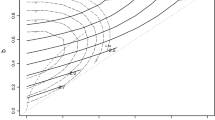Abstract
When there are two alternative random-effect models leading to the same marginal model, inferences from one model can be used for the other model. We illustrate how a likelihood method for fitting models with independent random effects can be applied to seemingly very different models with correlated random effects. We also discuss some merits of using these alternative models.
Similar content being viewed by others
References
Breslow N.E. and Clayton D.G. 1993. Approximate inference in generalized linear mixed models. J. Amer. Statist. Assoc. 88: 9–25.
Gruttola V.D. and Tu X.M. 1994. Modelling progression of CD4-lymphocyte count and its relationship to survival time. Biometrics 50: 1003–1014.
Ha I.D. and Lee Y. 2003. Estimating frailty models via Poisson hierarchical generalized linear models. Journal of Computational and Graphical Statistics 12: 663–681.
Ha I.D., Lee Y. and Song J.K. 2001. Hierarchical likelihood approach for frailty models. Biometrika 88: 233–243.
Ha I.D., Lee Y. and Song J.K. 2001. Hierarchical likelihood approach for mixed linear models with censored data. Lifetime Data Analysis 8: 163–176.
Harville D.A. 1977. Maximum likelihood approaches to variance component estimation and related problems. J. Amer. Statist. Assoc. 72: 320–340.
Kenward M.G., Verbyla A., Welham S., Cullis B. and Lessaffre E. 2001. Proceedings in the 2001 spring meeting of the International Biometric Society Eastern North American Region. Jointly with IMS and Sections of the ASA.
Lee Y. and Nelder J.A. 1996. Hierarchical generalized linear models (with discussion). J. R. Statist. Soc. B 58: 619–678.
Lee Y. and Nelder J.A. 2001a. Hierarchical generalised linear models: A synthesis of generalised linear models, random effect models and structured dispersions. Biometrika 88: 987–1006.
Lee Y. and Nelder J.A. 2001b. Modelling and analysing correlated non-normal data. Statistical Modelling 1: 3–16.
Longford N. 1995. Random Coefficient Models. Clarendon Oxford.
Ma R., Krewski D. and Burnett R.T. 2003. Random effects Cox models: A Poisson modelling approach. Biometrika 90: 157–169.
Matsuyama Y. and Ohashi Y. 1997. Mixed models for bivariate response repeated measures data using Gibbs sampling. Statistics in Medicine 16: 1587–1601.
Park S., Palta M. Shao J. and Shen L. 2002. Bias adjustment in analysing longitudinal data with informative missingness. Statistics in Medicine 21: 277–291.
Rasbash J., Browne W., Harvey G., Yang M., Plewis I., Healy M., Woodhouse G., Draper D., Langford I. and Lewis T. 2000. A user's guide to MLwiN; version 2.1c, Centre for Multilevel Modelling. Institute of Education, University of London.
Therneau T.M. and Gramsch P.M. 2000. Modelling Survival Data: Extending the Cox Model. Springer-Verlag, New York.
Author information
Authors and Affiliations
Corresponding author
Rights and permissions
About this article
Cite this article
Lee, Y., Nelder, J.A. Fitting via alternative random-effect models. Stat Comput 16, 69–75 (2006). https://doi.org/10.1007/s11222-006-5534-4
Received:
Accepted:
Issue Date:
DOI: https://doi.org/10.1007/s11222-006-5534-4




